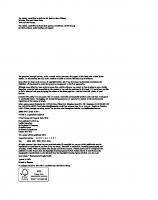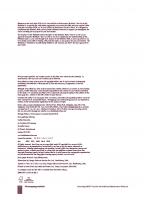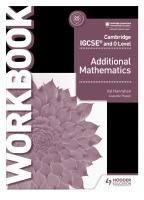Cambridge IGCSE and O Level Economics (Cambridge Igcse & O Level) [UK ed.] 1444196413, 9781444196412
Communicate Economics to your students with the most up-to-date and internationally focused textbook available. Written
1,350 153 44MB
English Pages 304 [305] Year 2013
zoompage1
zoompage2
zoompage3
zoompage4
zoompage5
zoompage6
zoompage7
zoompage8
zoompage9
zoompage10
zoompage11
zoompage12
zoompage13
zoompage14
zoompage15
zoompage16
zoompage17
zoompage18
zoompage19
zoompage20
zoompage21
zoompage22
zoompage23
zoompage24
zoompage25
zoompage26
zoompage27
zoompage28
zoompage29
zoompage30
zoompage31
zoompage32
zoompage33
zoompage34
zoompage35
zoompage36
zoompage37
zoompage38
zoompage39
zoompage40
zoompage41
zoompage42
zoompage43
zoompage44
zoompage45
zoompage46
zoompage47
zoompage48
zoompage49
zoompage50
zoompage51
zoompage52
zoompage53
zoompage54
zoompage55
zoompage56
zoompage57
zoompage58
zoompage59
zoompage60
zoompage61
zoompage62
zoompage63
zoompage64
zoompage65
zoompage66
zoompage67
zoompage68
zoompage69
zoompage70
zoompage71
zoompage72
zoompage73
zoompage74
zoompage75
zoompage76
zoompage77
zoompage78
zoompage79
zoompage80
zoompage81
zoompage82
zoompage83
zoompage84
zoompage85
zoompage86
zoompage87
zoompage88
zoompage89
zoompage90
zoompage91
zoompage92
zoompage93
zoompage94
zoompage95
zoompage96
zoompage97
zoompage98
zoompage99
zoompage100
zoompage101
zoompage102
zoompage103
zoompage104
zoompage105
zoompage106
zoompage107
zoompage108
zoompage109
zoompage110
zoompage111
zoompage112
zoompage113
zoompage114
zoompage115
zoompage116
zoompage117
zoompage118
zoompage119
zoompage120
zoompage121
zoompage122
zoompage123
zoompage124
zoompage125
zoompage126
zoompage127
zoompage128
zoompage129
zoompage130
zoompage131
zoompage132
zoompage133
zoompage134
zoompage135
zoompage136
zoompage137
zoompage138
zoompage139
zoompage140
zoompage141
zoompage142
zoompage143
zoompage144
zoompage145
zoompage146
zoompage147
zoompage148
zoompage149
zoompage150
zoompage151
zoompage152
zoompage153
zoompage154
zoompage155
zoompage156
zoompage157
zoompage158
zoompage159
zoompage160
zoompage161
zoompage162
zoompage163
zoompage164
zoompage165
zoompage166
zoompage167
zoompage168
zoompage169
zoompage170
zoompage171
zoompage172
zoompage173
zoompage174
zoompage175
zoompage176
zoompage177
zoompage178
zoompage179
zoompage180
zoompage181
zoompage182
zoompage183
zoompage184
zoompage185
zoompage186
zoompage187
zoompage188
zoompage189
zoompage190
zoompage191
zoompage192
zoompage193
zoompage194
zoompage195
zoompage196
zoompage197
zoompage198
zoompage199
zoompage200
zoompage201
zoompage202
zoompage203
zoompage204
zoompage205
zoompage206
zoompage207
zoompage208
zoompage209
zoompage210
zoompage211
zoompage212
zoompage213
zoompage214
zoompage215
zoompage216
zoompage217
zoompage218
zoompage219
zoompage220
zoompage221
zoompage222
zoompage223
zoompage224
zoompage225
zoompage226
zoompage227
zoompage228
zoompage229
zoompage230
zoompage231
zoompage232
zoompage233
zoompage234
zoompage235
zoompage236
zoompage237
zoompage238
zoompage239
zoompage240
zoompage241
zoompage242
zoompage243
zoompage244
zoompage245
zoompage246
zoompage247
zoompage248
zoompage249
zoompage250
zoompage251
zoompage252
zoompage253
zoompage254
zoompage255
zoompage256
zoompage257
zoompage258
zoompage259
zoompage260
zoompage261
zoompage262
zoompage263
zoompage264
zoompage265
zoompage266
zoompage267
zoompage268
zoompage269
zoompage270
zoompage271
zoompage272
zoompage273
zoompage274
zoompage275
zoompage276
zoompage277
zoompage278
zoompage279
zoompage280
zoompage281
zoompage282
zoompage283
zoompage284
zoompage285
zoompage286
zoompage287
zoompage288
zoompage289
zoompage290
zoompage291
zoompage292
zoompage293
zoompage294
zoompage295
zoompage296
zoompage297
zoompage298
zoompage299
zoompage300
zoompage301
zoompage302
zoompage303
zoompage304
zoompage305
Recommend Papers
![Cambridge IGCSE and O Level Economics (Cambridge Igcse & O Level) [UK ed.]
1444196413, 9781444196412](https://ebin.pub/img/200x200/cambridge-igcse-and-o-level-economics-cambridge-igcse-amp-o-level-uk-ed-1444196413-9781444196412.jpg)
- Author / Uploaded
- Paul Hoang
- Margaret Ducie
File loading please wait...
Citation preview
ENDORSED BY
l:},;J CAMBRIDG E '< f / International 1-:xaminatinns
Cambridge
IGCSE® and O Level
Economics Paul Hoang Margaret Ducie
/.
HODDER
'EDUCATION
Economics Paul Hoang and Margaret Ducie
'., ~D~~R1~~
AN HACHETTE UK COMPANY
® !GCSE is the registettd trademark of Cambridge International Examination,
The questiOfls, example answers, marks awarded and/or rommems that app lsaooted
~P,
=~:t:
~P.
~~.:;:::" "'
0
Q,j
a.
Q,
O...OOti!ytmded
Figurel .1 2 Excesssupply(surplus)
By contrast, if the selling price of a product is set too low (i.e. below the equilibrium price), the demand will exceed the supply. This creates a shortage in the market, caused by the ei:cess de mand (see Figure 3. 13). At a price of P1, the demand is Qd while supply is only Q, so demand exceeds supply. The excess demand causes prices to rise back to the equilibrium price of P,. When Apple launched its iPhone 5 in Hong Kong in late 20 12, demand outstripped supply so much that the price of the smartphone increased from H K$5588 to almost H K$8000 - an increase of43 per cent!
Ashoooge =
;;;:
;~.~-,.:;,..
0
marle!equ lli b-ilXll
P, 0
Q,
a.
G.!
O...OOti!ytmded
Figurel .13
•
'NOOndemaodexceed,
:L
Excessdemand(shortage)
The a/location of resources: how the market works; market failure
Exam practice 1
Using an appropriate demand and supply diagram, explain the impact on the market price and quantity traded in each of the following cases: a) The market for air travel following the imposition of higher fuel taxes. b) The market for Pepsi Cola following a fall in the price of Coca-Cola. c) The market for sushi following a successful marketing campaign promoting the health benefits from eating rice and rcHJ fish. d) The market for Samsung digital cameras following new technologies that improve productivity in its factories.
2
[5] [5] [5] [5]
In 2012, Danish toymaker LEGO launched LEGO Friends to appeal primarily to girls. The products include mini-doll figu res, pink and purple toy sets and pets. Founded in 1949, LEGO's popular toy construction bricks were targeted mainly at boys with popular LEGO theme sets such as LEGO Racers, LEGO Star Wars, LEGO Batman and LEGO Ninjago. In early 2013, the San Francisco Chronicle reported that LEGO had sold twice as many of the LEGO Friends toys as was expected. The company said that demand from children and their families was overwhelmingly positive. Business Week reported that LEGO had spent $40 million in its global marketing of LEGO Friends. a) Define the term 'demand'. [2] b) Explain two possible reasons for the higher than expected demand for the LEGO Friends toy construction bricks.
3
[6]
Below is a demand and supply schedule for carrots in a country. Priteperkg (S)
Quantitydemanded permonth (kg)
Quantity supplied per month(kg)
a) Plot and label the demand and supply curves on a suitable graph. Establish the equilibrium price and quantity traded.
[6]
b) Using your graph, determine the excess demand at a price of $5 per kilo. c) Using your graph, determine the excess supply at a price of $8 per kilo.
[2] [2)
Demand and supply
Chapter review q uestions 1 2 3 4
Whatismeantby'demand'? Whatismeantby'supply'? Outline the factors that affect the level of demand for a product. Outline the factors that affect the level of supply for a product. S How is equilibrium price and quantity traded determined? 6 What is the difference between excess demand and excess supply? 7 What is the difference between a shift and a movement in demand and supply analysis?
Key te r ms Cotnp lements areproductsthataredemanded(fortheiruse)togetherwithotherproducts. For example, tea and milk or the cinema and popcorn are jointly demanded. Demand refers to the willingness and the ability of customers to pay a given price to buy a good or service. The higher the price of a product, the lower its demand tends to be. Equil ibrium occurs when the quantity demanded for a product is equal to the quantity suppliedoftheproduct(i.e. therearenoshortagesorsurpluses). Exnn demand occurs when the demand for a product exceeds the supply of the product at certainpricelevels. Thishappenswhenthepriceissetbelowtheequilibriumprice,resulting in shortages. bc1Hs supply occurs when the supply of a product exceeds the demand at certain price levels. Thisresultsinasurplusbecausethepriceistoohigh(i.e. abovethemarket equilibrium price). 5ubstltut•s areproductsthatareincompetitivedemandastheycanbeusedinplace of each other. For example, tea and coffee or McDonald's and Burger King meals are substitute products. Si.Jpply is the willingness and the ability of firms to provide a good or service at given prices. Thehigherthepriceofaproduct,thehigheritssupplytendstobe.
@
Price elasticity By the end of this chapter, you should be able to: • define price elasticity of demand and supply and perform simple calculations • demonstrate the usefulness of price elasticity in particular situations such as revenue changes and consumer expenditure. Taken from Cambridge International ExamiJlabom ~la bus (IGCSE 0455/0 Level 228 1) O CambetJouma/andT/Mf8u5ines,
Discusshowtheconceptofpriceelasticityofdemandanditsdeterminantscanhelpto explain why Toyota Motor Corporation is the world's largest car-maker.
PED, consumer expenditure and revenue changes Knowledge of the price elasticity of demand for a product can be used to assess the impact on consumer expenditure and therefore sales revenue following changes in price. Sales revenue is the amoum of money received by a supplier from the sale ofa good or service. It is calculated by multiplying the price charged for each product by the quamitysold, i.e. Rc~·enue = price x quantity demanded Note that this is not the same as profit, which is the numerical difference between a firm's sales revenues and its total costs of production. For example, if Leno.•o sells 5000 laptops at $700 each in the first quarter of the month, its sales revenue is $3.5 million. Suppose that the computer maker reduces its price to $650 and quantity demanded rises to 5200 units in the following quarter. Was this a gcxxi business decision?
The a/location of resources: how the market works; market failure A quick calculation of PED reveals that the demand fur Lenom laptops is price elastic: 550 ~~000 x l 00 = +10%
• percenrage change in quantity demanded= • percenrage change in price= $
65 7 ~; ~ 00 x 100 = - 7. 14% 0
• thus, PED= 1.4 This means the PED fur Lenovo laptops is price elastic. Hence a fall in price causes a relatively larger increase in the quantity demanded, so sales revenues should increase. This can be checked as follows: original sales revenue = $700 x 5000: $3 500000 new sales revenue = $650 x 5500 = $3 575 OOO difference in sales revenue= $3.575m - $3.5m = +75000 Given that demand fur LenO\'O laptops in the above example is price elastic, a reduction in price was a sensible business decision. Therefore , it can be seen that knowledge of PED fur a product can infurm firms about their pricing strategy in order to maximise sales revenues. These relationships are summarised in Table 4. 1 and and Figures 4.6 and 4.7. Ta ble4.1
TherelationshipbetweenPEDandsalesrevenue
Price chan ge
Inel a sti c
Increase price Reduce price
Figure4.6
Revenues fall
Unita ry
Elas ti c
No change in revenues
Revenues fall
No change in revenues
Price inelasticdemandandsalesrevenue
=~~tj.!.,vfu p
resporu;M!1ochange, ln ~el . A
1
:~r.:~:~,*:=C:.&f
~ j p~
1oa contra.ll. lfp
For example, if the market price of beans increased from $2 per kilo to $2.20 per kilo, causing quantity supplied to rise from 10000 units to 10 500 units, then the PES is calculated as: • percentage change in quantity supplied=
105
~~~000 x lOO = +5%
2 2 • percentage change in price= $ .2~ ~ $ .0 x 100 = +1 0% 20
• PES=~=0.5 +10%
CD
The a/location of resources: how the market works; market failure What this means is that the supply of beans is hardlyaflectcd by the change in price supply is relatively price inelastic. Note that the value of PES is fX>Sirive due to the law of supply - that is, an increase in price rends to increase the quantity supplied (and vice versa). The value of PES reveals the degree to \\11ich the quanrity supplied ofa product responds to changes in price. The calculation of PES generally has two possible outcomes: • If PES > 1.0 supply is price elastic, i.e. supply is responsive to changes in price (the percentage change in quantity supplied is greater than the percentage change in price-see Figure4.8). • If PES < 1.0 supply is price inelastic, i.e. quanriry supplied is relatively unresponsive to changes in price (percentage change in quantity supplied is less than the percentage change in price - sec Figure 4.9).
Qxi ntitywppled
Figure4.9 Thepriceinelasticsupplycurve
H owever, there are three special cases which are theoretical possibilities for PES:
•
• If the PES ofa product is equal to 0, then supply is perfectly price inelas t ic: that is, a change in price has no impact on the quanrity supplied. This suggests that there is absolutely no spare capacity for suppliers to raise output, irrespective of increases in price (see Figure 4.10). • If the PES of a product is equal to infinity ("") then supply is perfectly pr ice elas t ic: that is, the quanriry supplied can change without any corresponding change in price. For example, a software developer selling products online can very easily increase supply to match higher levels of demand, without any impact on the price level. Due to the spare capacity that exists, suppliers are able to raise output at the current price level (see Figure 4.11).
Price elasticity • If the PES for a product is equal to l then supply has unitar y price elas t icity: that is, the percentage change in the quamit y supplied matches the proportional change in price (see Figure 4. 12). Any upwards sloping supply c.urve that starts at the origin will have unitary price elasticity.
LL
=1
p~
1
p1
=.':'1b'.:=C::e" ! I~~ :~h?" ;l:~~t!;l'ru-m0rtvale benefits are the benefits of production and consumption enjoyed by a firm, individual or government. l"rtvilte wsts of production and consumption are the actual costs of a firm, individual or government. Sodill benefits are the true (or full) benefits of consumption or production: that is, the sum ofprivatebenefitsandexternalbenefits. Sociill costs are the true (or full) costs of consumption or production: that is, the sum of privatecostsandextemalcosts. A subs idy is a sum of money given by the government to a producer to reduce the costs of production or to a consumer to reduce the price of consumption.
(!) Money By the end of this cha pter, you sho uld be able to: • •
describe the functions of money and the need for exchange describe the functions of central banks, st ock exchanges and commerci al banks.
Taken from Cambridge International ExamiJlabom ~la bus (IGCSE 0455/0 Level 228 1) O Cambd companies (sec Chapter 10). lt provides a platform for individuals, organisations and govcrnmcms to buy and sell shares. Examples of stock exchanges arc the New York Stock Exchange (NYSE), London Stock Exchange, Frankfurt Stock Exchange, Shanghai Stock Exchange and Bombay Stock Exd1angc. The efficient functioning ofa stock exchange helps to create business and consumer confidence, thereby boosting investmcm opportunities in the economy.
The individual as producer, consumer and borrower
The Bom bay Stock Exchange
Func tions of a srock exchange include t he following: • R.a.ising share capital for businesses - As a marketplace for buying shares, the srock exchange provides public limited companies (see Chapter 10) with the facility to raise huge amounts of finance for business growt h and expansion (see Figure 6.2). This is done by selling shares in the company to t he general public. Share capital (the money raised from selling shares in the company) is the main source of finance for public limited companies. Many businesses decide to 'go public' by selling their shares on a stock exchange for the first time - a practice known as an initial public offerin g (IPO). Popular I POs are heavily o,,ersubscribed (the quantity demanded outstrips the quantity suppliL>d ) and this forces up the share price. Existing companies that are listed on a stock exchange can raise more share capital by selling additional sales in a share issue (or a share placement). Howe~w, by issuing more shares, ownership and control of the company become weakened. Tab le6.1
Thewo rld'slargestinitialpublicofferings
Compa ny
Share ca p ita l ra ised(US$bn)
Agriculture Bank of China lndustrialandCommercialBankofChina AmericanlntemationalA11urance Nn Mobile Communications Network Source: ad"!'led from Reute" .com ar>d ~orbes
• Facilitating company g rowth- In addition to making an !PO, existing companies can choose to sell additional shares to raise funds to finance their growth. T his process is known as a share issue. For example, Perrobras - Brazil's largest oil company - managed to raise $70 billion from selling additional shares the general public in September 2010.
to
Money The stock exchange also functions to facilitate the growth of companies through mergers and acquisitions (see Chapter 14 ). For instance, Walt Disney Company acquired Lucasfilm (creators of the best-selling Star Wars franchise) via the New York Stock Exchange in 2012 for $4.05 billion.
Darth Vader and other Star Wars characters ring the opening bell at the New York Stock Exchange
• Faci litating the sale of government bonds - Gm·ernments can raise capital to fund their development projects via the stock exchange, which sells securities known as bonds (a type ofloan). Bondholders do not ha\·e ownership rights, but earn interest based on the number of bonds bought and the prevailing interest rate. Government bonds can be bought and sold through the stock exchange by the general public, such as individuals, companies and other governments. The finance raised is often used to fund infrastructure projects such as the construction of mororways (higln\'ays), sewage and water treatment systems, and public housing projects. • P rice mechanism for t rad ing shares - Share prices are generally determined by the relati\'e forces of demand and supply (see Chapter 3). Price fluctuations and the valuation of share prices are handled by the stock exchange. This ftmction of the stock exchange provides imix,nam and up-to-date information to both buyers and sellersinthestockmarket. • Safet y o f t ra nsactio n - All companies that trade on a stock exchange are regulated. The share dealings of public limited companies are defined in accordance with the country's legal framework. This helps to boost the level of confidence in buying and selling shares. Thus, this function of a stock exchange can have a large impact on the economic growth prospects of a count!)' as it facilitates capital formation (investment). Activity Usetheinternettofindouttheworld'sfivelargeststockexchanges. Whatarethe benefitstobusinessesthatarelisted(tradetheirshares)onlarge,well-knownstock exchanges?
The individual as producer, consumer and borrower
Exam practice In May 2012, social media giant Facebook's initial public offering (IPO) on the New York NASDAQ Stock Exchange raised $16 billion (the third largest amount in US history) from investors buying shares at $38 apiece. This led to the company's valuation standing at $104 billion, the largest valuation of a newly listed public limited company to date. 1 2 3
Define the term 'initial public offering'. Explain two functions of a stock exchange such as the NASDAQ Stock Exchange.
[2) (4)
Comment on why Facebook might have decided to float its shares on the New York Stock Exchange. [4)
The functions of commercial banks A commercial ban k is a retail bank that provides financial services to its customers, such as accepting savings deposits and approving bank loans. Examples of commercial banks are listed in Table 6.2. All commercial banks are responsible for maintaining the deposits of their account holders. Their transactions are socially and legally governed by the central bank. Commercial banking started over 200 years ago when goldsmiths (metal workers specialising in precious metals such as gold) operated as banks. Banking itself can be traced as fur back as 2000 BC when merchants in Assyria and Babylonia used grain Joans to farmers and other traders. Modern commercial banking using the internet (c -banking) did not start until 1995. Tab le6.2 Rank
Theworld'slargestcommercialbanks,2012 Bank
Country
lndustrialandCommerdalBankofChina(ICBC}
China
China Construction Bank
China
Well~Fargo&Co HongKongandShanghaiBankingCorporation(HSBC} Agricultural Bank of China 6
China
JPMorgan Chase Bank of China ltauUnibanco
China Brazil
Citigroup 10
Commonwealth
Australia
The functions of commercial banks can be split into two categories: primary and secondary (or general utility) functions. The primary functions of commercial banks include the following: • Accepting deposits - Commercial banks accept deposits from their customers, including private individuals, businesses and governments. Examples include sight deposits (which arc payable on demand ) and time deposits (which arc deposits that are payable after a fixed time period such as 6 months or a
Money year). Time deposits tend to attract higher rates of interest for deposit holders than sight deposits. Businesses deposit their cash in commercial banks for the convenience of their own financial operations, such as paying their suppliers and employees. • Makin g adva nces - Commercial banks provide advances (loans) to their customers. These advances include overdrafts (a banking service that allows registered customers to withdraw more money than they actually have in their account) and mortgages (long-term secured Joans for the purchase of assets such as commercial and residential property). • Credit creatio n - This describes the process by which banks increase the supply of money in an economy by making money available to borrowers. Credit allows the borrower (or debtor) to gain purchasing power (money) now with the promise to pay the lender (or creditor) at a future time. Credit creation enables commercial banks to generate considerable additional purchasing power from their cash deposits. \Vhile central banks can prim money, they do not create credit; this is a key function that distinguishes commercial banks from other financial institutions, such as insurance companies and investment banks. The secondary functio ns (or general utility functions) of commercial banks include: • collecting and clearing cheques on behalf of their clients • offering additional financial services, such as rax advice, foreign exchange dealings and the buying and selling of shares • providing safety deposit boxes for customers to safeguard highly valued possessions, including items of jewellery and important documents such as wills • providing money transfer facilities, such as transferring money to an overseas bank account or paying various bills, such as telephone, electricity, gas and water bills • providing credit card fucilities for the convenience of customers - both private individuals and commercial clients • providing internet banking facilities, such as online bill payments, online bank transfers between bank accounts and the online purchase of shares and foreign currencies.
Credit cards allow customers to buy now and pay later, so are widely used as a medium of exchange
The individual as producer, consumer and borrower
Exam practice According to The Economist, China's economy is expected to overtake the USA's by as early as 2018. Multinational companies hoping to make the most of this opportunity have been investing in China via the Shanghai Stock Exchange. Commercial banks such as the Industrial and Commercial Bank of China (ICBC) and the Hong Kong and Shanghai Banking Corporation (HSBC) also have an increasingly important role in the development of the Chinese economy. Nevertheless, the trading of the renminbi, China's official currency, is still closely monitored by the People's Bank of China - the central bank. Describe the functions of a commercial bank such as ICBC or HSBC.
[4]
2
Explain the key functions of central banks such as the People's Bank of China.
[4]
3
1
Explain how the Shanghai Stock Exchange can play a key role in the economic development of the Chinese economy.
[4]
C h apter review questions 1 What is meant by money and what are its main characteristics? 2 3 4
What are the key functions of money? What is a central bank and what are its key functions? What is a stock exchange and what are its main functions? What are commercial banks and what are their main functions? How does a central bank differ from commercial banks?
Key te rms Barte ring istheactofswappingitemsinexchangeforotheritemsthroughaprocessof bargaining and negotiation. A centra l ba nk is the monetary authority that oversees and manages the supply of money andthebankingsystemofthenation . Co mme rc.la lba nk s areretailbanksthatprovidefinancialservicestotheircustomers,suchas accepting savings account deposits and approving bank loans. Functions of money describes the role that money plays in the economy: money is a medium of exchange, a store of value and a measure of value (or unit of account). Mon ey isanythingthatiswidelyacceptedasameansofexchange(andactsasameasure and store of value). Mo ney supp ly refers to the amount of money in the economy at a particular point in time. Astockexchangeisaninstitutional marketplacefortradingthesharesofpubliclimited companies.
0
Labour markets By the end of this chapter, you should be able to: • identify the factors affecting an individual's choice of occupation (wage factors and non-wage factors)
• •
describe likely changes in earnings over time for an individual describe the differences in earnings between different groups of workers (male/female; skilled/unskilled; private/public; agricultural/manufacturing/
services) •
describe the benefits and disadvantages of specialisation for the individual.
TakenfromCambriclgelnternational fxamiMtionsSyllabo,~GC5f0455/0l.evel2281 ) C CambfidgelnternationalExaminabom
Influ ences o n a n individual 's choice of occupatio n Most people work at some point in their lives. An individual's choice of occupation depends on many factors, which can be categorised as wage and non-wage factors. Wage facto rs affecting cho ic e of occupation T he lc\'el of sa lary or wage that a person receives in return for their labour is a major influence on their choice of occupation. Table 7.1 outlines t he different methods of payment by which a worker may be paid in return for their labour. Ta ble 7.1
Different methods of payment for labou r
Method s of payment
Explana tion
Examples
Wages
Wages are paid hourly or Wei!kly, 10 are avariableco1ttofirms Salariesarepaidmonthlyatalixed value,!;Oarefixedco1ts
Part-time workers in a shop or restaurant(e.g. $7 per hour} Full-timejob{e.g.teachers,shop managersandnur~s)
A fixed amount paid per item produced or sold
Workers producing individual items inafactory{e.g.S2pergarment completed)
Apercentageofthevalueof product:5or1ervicessold
Realestateagentsearning1%of thevalueofeac:hpropertythat they sell
Anadditiooallumpsumofmoney paidduringyear,usuallydependent upon performance
RoyalBankafScotlandand 8ardayspaid523staffmembers morethan£1m(S1.56m}in bonusesin2013
Salary
Profit-related pay
Payment related to the profits earned by a firm
A partner in a law firm may receive 20%oftheannualprofits
Share options
Workers receive shares in the firm, 1otheyhavean incentivetowork hardsothatthefirmi1profitable
Public limited companies
Fringebenefits(orperks)
Additionalbenefits,whichhavea monetary value
Pensions,healthinsurance. companyrnr,laptop,mobile phone,educ.ationforchildren,or membershipofahealthdub
The individual as producer, consumer and borrower Non-wage factors Non-wage fuctors are also a major influence on an individual's choice of occupation, as a person may be motivated by money in the short term but in the long term the y will also wam to feel happy and motivated at work. Non-,vage factors that influence an individual's choice of occupation include the following: • Level of challenge - does the job require thinking skills or is it repetitive and boring? • Career prospects - will there be progression within the firm or will a person have to change jobs to be promoted? • Level of danger involved - is the job dangerous? For example, some people face a high degree of risk at work, such as lifeboat rescue teams, firefighrcrs, window cleaners and scaffold erectors.
Worker erecting bamboo scaffold ing in Hong Kon g
• The leng th of training required - Some jobs require few skills, such as cleaners and shop assistams. By conuast, ot her jobs require years of training, such as electrical engineers, plastic surgeons, pilots, accounrams, lawyers and demists. • The level of education required - Some jobs require no or minimal education whereas other jobs require post-graduate le\'els of education (such as university professors). • Recognition in the jo b - does the worker get praise and recognition for t heir performance at work? !fa worker feels respected at work, they may be motivated to work harder. • Personal satisfa ction gained from the job - This is imporram because if a worker feels satisfied and happy in their work, they may work harder and stay in t he job longer. Volumary work might be carried out by people who are happy to work for no pay, as the reward they get is the personal satisfanion of,,vorking for a d1arity, such as taking care of the elderly or sick. • The level of ex perience required - Some jobs require no or minimal experience whereas other jobs require a minimum amount of experience (such as judges and Jaw-makers).
Labour markets
Activity lnterviewseveraladultsandaskthemthefinancialandnon-financialreasonswhythey chosetheiroccupation. Shareyourfindingswiththerestoftheclass.
Changes in earning s over a lifetim e Earnings change over a person's lifetime (see Table 7.2) for the following reasons: • The level of education a person has tends to affect, in most cases, their earnings and earning potential (see Table 7.3). • I nexperienced workers, such as graduates in their first year of work, earn Jess than experienced workers. • Salaries and wages usually increase with experience and rime spent working ar a firn1. • After workers reach the peak of their career, their salaries and wages tend to remain fairlyconsram. • After retirement, earnings full and people are dependent on their pensions and savings to co\'er their living expenses. Table7.2
Earningsbyage,full-timeworkers(UK,2010-2012)
Age category
2010(£)
2011 (£)
2012(£)
Allempl(lf)'ees
Sou,ce: adaptedfromOlhcelmNabooalStabstics
Ta bl e 7.3 After-taxearningsbyeducationalatta inment(USA,2011-2012) Less than college graduate
College graduate Bachelor's degree
Mean income after
taxes{Sl
I
45 903
I I
Master's, p,ofm;oaal, doctoral degree
Sou,ce:~daptedfromUSDepartmentfWers means rhar laOOur unions arc not in such a strong bargaining position to obtain higher wages (see Chapter 8). Strong trade unions ha\·e often been able to demand annual pay rises in excess of inflation and the marker equilibrium level. H ence, government intervention to reduce the influence and po\\-er of trade unions can help to reduce classical (real-wage) unemployment.
Economic indicators 0 Employment incentives can be offered to firms for training and hiring the long-term unemployed. For example, the govemmem can offer firms tax allowances and/or subsidies to reduce their costs ofttaining and hiring workers. Similarly, enterprise zones (see Chapter 16) could be set up in areas of high unemploymem to create jobs. However, firms might be reluctam to do so because of the lower pnxluctiviry and higher risk of hiring the Jong-term unemployed. 0 A review of welfare benefits ensures that there are incemh-es to seek employment rather than to rely on state welfare benefits. !fit is made more diffic.ult for people to claim unemployment benefits, they become more proactive in searching for jobs. This could significamly help to reduce unemployment. While supply-side policies tend to have more permanent impacts on employment, these effects take longer to accomplish compared with demand-side policies aimed at reducing unemployment in the economy.
Exam practice In June 2010, Tesco opened Britain's first supermarket without any checkout workers. Instead, one person is hired to supervise the five checkouts, mainly to assist customers who have not used a self-service checkout before. The UK's largest retailer employs around 221 OOO workers in the UK, but critics argue that such technological advancement will cause mass job losses. Soorce;adaptl'dfromDailyMai/Online
1 Define the term 'technological unemployment'. 2 Analyse the WclfS in which the UK government could reduce technological unemployment.
Chapter review questions 1 How does the pattern of employment in the three production sectors change as an economy develops? 2 Why has there been a delay in most developed countries for labour to enter the workforce? 3 How have ageing populations in developed economies affected employment patterns? 4 How does the International Labour Organisation measure unemployment? 5 How is the unemployment rate calculated? 6 Why is employment a macroeconomic objective of all governments? 7 Outline the main types (and hence the causes) of unemployment. What are the consequences of high unemployment in the economy? What are the four main government policies that can be used to reduce domestic unemployment? 10 Give three examples of supply-side policies that can be used to reduce unemployment.
[2) [6)
Employment
Key terms Employment refers to the use of factors of production in the economy, such as labour. Unemp loyment occurs when people of working age are both willing and able to work but cannot find employment. The unemployment rate is a measure of the percentage of a country's workforce that is out of employment. The w ork ing po pu lation (or labour force) is the number of people in an economy who are of working age and who are willing and able to work.
@) Economic growth By the end of this chapter, you should be able to: • • •
define 'gross domestic product' (GDP) describe and have a general understanding of the causes and consequences of economic growth define the term 'recession'
•
describe and evaluate measures and indicators of comparative living standards, such as GDP per head and human development index (HDI).
Taken from Cambfidge International Examir>abom Syllabus (IGCSE 0455/0 Level 2281 )
O Cambridgelntematkm~IExamir,atioo,
Gross domestic product and economic growth Gross domestic product (GDP) measures the monetary value of goods and services produced within a country for a given period of time, usually one year. The comix,nems of GDP are as follows: • Consumptio n expenditu re (C ) - This refers to the total spending on goods and services by individuals and households in an economy. Examples of consumer expenditure are the economy's spending on housing, transport, food, clothing and domestic. holidays. • Investment expenditure (I) - This refers to the capital expenditure of firms whicl1 is used to further production and expand the economy's producth·e capacity. Examples are the spending on new machinery and the constrnction of new fuctories. • Go ve rnment ex penditure (G) - This is the total consumption and investment expenditure of the government. Examples are the spending on infrastrucrnre (such as rail and road networks) and the construction of new schools and hospitals. • Export earnings (X ) -This measures the monetary value of all exports sold to foreign buyers. For example, France exports a huge amount of wine, dairy products and fruits, so the earnings from these exports are calculated in the measure of GDP. • Import expenditure (M ) - This measures the monetary value of the payments made for all imports. France imports a lot of cars, oil and smartphones. The spending on these items means that money leaves the French economy, so this must be deduned from its calculation ofGDP. The difference between the value of a country's exports and imports (X - M ) is called net ex ports.
Therefore, GDP is calculated using the formula: GDP:C+l+G+ (X-M )
A ctivity Discussinpairsthereasonsforthefollowing: 1 Whygovernmentspendingoninfrastructure(suchasroadandrailnetworks)and training programmes for the unemployed are examples of investment expenditure. 2 Whythespendingbyforeigntouristsin ParisrepresentsexportearningsforFrance. l Why investment is important for a country's economic growth.
Economic growth
Econo mic g rowth Econo mic growth is the increase in the level of national output - rhar is, the annual percentage change in GDP. Hence, in theory, an increase in any of the components of GDP (consumption, inwsunent, government spending and net exports) can cause economic growth. An increase in the quantity and/or the qualit y of f.tctors of production (see Chapter 1) can also create economic growth, such as an increase in the Jabour supply or improvements in the state of technology. Economic growth increases the Jong-term productive capacity of the economy, shown by an outward shift of the production possibility curve (see Chapter l and Figure 20. 1).
Ec=c gow,h=oo,oo=
~
dKJg r33 domond
![Cambridge IGCSE® and O Level: Economics [2 ed.]
9781510420205](https://ebin.pub/img/200x200/cambridge-igcse-and-o-level-economics-2nbsped-9781510420205.jpg)

![Cambridge IGCSE™ and O Level Environmental Management Workbook (Cambridge International IGCSE) [Workbook ed.]
9781316634875](https://ebin.pub/img/200x200/cambridge-igcse-and-o-level-environmental-management-workbook-cambridge-international-igcse-workbooknbsped-9781316634875.jpg)






![Cambridge IGCSE® and O Level Economics Coursebook (no watermark) [2 ed.]
9781108440387, 110844038X](https://ebin.pub/img/200x200/cambridge-igcse-and-o-level-economics-coursebook-no-watermark-2nbsped-9781108440387-110844038x.jpg)